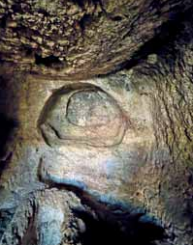The oldest phase of the necropolis is attested on the top of the hill where, in the 19th and 20th centuries, shaft tombs with grave goods dating to the Punic period and rock-cut incineration tombs from the late Republican Roman period, probably pertaining to a small settlement, were found, located in the flat area below, obliterated, in the early centuries of the Roman-Imperial period, by the expansion of the vast eastern necropolis of Karales; a patch of such a necropolis, highlighted in the late 1980s in the area adjacent to the cemetery, consisted of masonry inhumation graves at cupa, tumulus, cappuccina style inside deep pits, and incinerations in glass urns, in pits or inside limestone and earthenware ollars. Underneath the building facing the cemetery, which is currently used for storage, a brick mausoleum is still preserved around which are some cupae, a mound tomb and some parallelepiped-shaped ollari. In the early medieval period the necropolis occupied the hill, on whose sides were excavated chamber tombs with inhumations in arcosolium, decorated with frescoes and mosaics. Nineteenth-century work revealed numerous chamber tombs; in particular, two cubicula, named Jonah’s and Munazio Ireneo’s, were found. The former featured a fresco depicting scenes from the cycle of the prophet Jonah, taken from the Old Testament; the latter bears the name of the deceased that can be obtained from an inscription embedded in the back wall. The frescoes, in very poor condition, deteriorated irretrievably in a short time; the Municipality of Cagliari took care of the preservation of the two cubicles, incorporating them into the modern cemetery and carrying out some masonry works and arrangement of the access.









